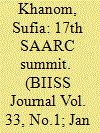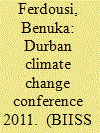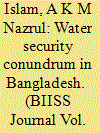|
|
|
Sort Order |
|
|
|
Items / Page
|
|
|
|
|
|
|
| Srl | Item |
| 1 |
ID:
117740


|
|
|
|
|
| Publication |
2012.
|
| Summary/Abstract |
This paper attempts to analyse the discussed issues and outcomes of the seventeenth SAARC Summit which took place in the Maldives from 10-11 November 2011 with a special reference to Bangladesh in the context of regional cooperation. Several significant and strategically important agreements were signed during this Summit with the intention to begin a new era of cooperation among the member countries. Therefore, the Summit declaration adopted several treaties like SAARC Agreement on Rapid Response to Natural Disasters, SAARC Seed Bank, SAARC Agreement on Multilateral Arrangement on Recognition of Conformity Assessment, and the SAARC Agreement on Implementation of Regional Standards. The agreements focused on enhancing and facilitating regional transit and connectivity, economic growth, ensuring energy security, combating terrorism and human trafficking and fight climate change. Though the Summit has come up with some promising mutual agreements, its success will depend on their proper and timely implementation. The lack of political will, problem of poor governance, weak economy and disparity, crisis of political leadership, ethnic, socio-cultural and religious divisions, challenges of non-state actors, transnational security challenges are considered to be the major hindrances to the success of regional integration. The South Asian region should develop its own short, medium, and long-term strategies for economic integration where each stage should be implemented effectively before moving on to the next in order to build a sound foundation for progress. The inclusion of China as 'dialogue partner' would help SAARC to make the tangible progress for regional cooperation in South Asia. The new focus on regional integrations is likely to create exciting opportunities for Bangladesh if it can exploit the synergies based on comparative advantages, investment in cross-border infrastructure projects, address challenges in governance, environmental and social developments.
|
|
|
|
|
|
|
|
|
|
|
|
|
|
|
|
| 2 |
ID:
117743


|
|
|
|
|
| Publication |
2012.
|
| Summary/Abstract |
Climate change can be termed as the greatest challenge of the 21st century as the very existence of human civilisation on the planet Earth is at stake. It is, therefore, imperative to assess the United Nations (UN) Climate Change Conferences in order to see how far the world leaders have progressed to work out a climate regime capable of avoiding irreversible and catastrophic change in climate. This paper aims to make an assessment of the latest UN Climate Change Conference which was held in 2011 in Durban, South Africa. Besides presenting the outcome of the conference, the paper attempts to underline the factors that led to this outcome and analyses the role of different countries in this regard. The paper argues that climate change is not merely an issue of natural science; rather it is very closely linked to global economic and political structures. Hence, what is happening in UN climate negotiations is a reflection of global politics.
|
|
|
|
|
|
|
|
|
|
|
|
|
|
|
|
| 3 |
ID:
117742


|
|
|
|
|
| Publication |
2012.
|
| Summary/Abstract |
At the global level, use of water has increased significantly and it is on the rise, while its availability and access have reduced. Water is inherently linked to the growing challenges of the present day civilisation that include food security, health, economic growth, and poverty alleviation. In Bangladesh, availability of and access to water have appeared to be a significant obstruction to the survival and livelihood of its people and, sustainable economic growth of the country. Being the lowest riparian country in the Eastern Himalayan River systems, the water ecosystem of Bangladesh is vulnerable to unilateral upstream actions since a major share of surface water in the country comes from outside the border. This paper highlights that the main reason of Bangladesh water crises is the low flows of water due to upstream intervention by India which significantly affects surface water availability in Bangladesh during the dry period. Thus, during the dry period there always remains a gap between the need and availability. There is an increasing dependence on the use of groundwater which is depleting very fast due to over exploitation by a huge population. Climate change is likely to worsen the situation further. Due to severe gaps between the demand and supply of water there is a distressing impact on the live and livelihood of the population of Bangladesh which are manifested on the environment/non-traditional security sphere of the country. These, in course of time are likely to be posing severe threat to the security and stability of the country. The paper concludes that the management of common water resources taking into account the totality of Bangladesh-India common rivers could hardly be achieved without the involvement of all other stake holders which may include the Eastern Himalayan River systems co-basin states, particularly Nepal and Bhutan.
|
|
|
|
|
|
|
|
|
|
|
|
|
|
|
|
|
|
|
|
|